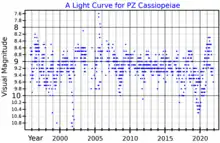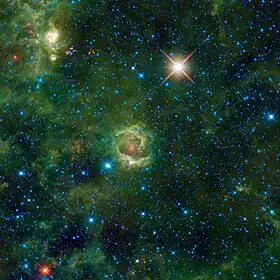| Observation data Epoch J2000 Equinox J2000 | |
|---|---|
| Constellation | Cassiopeia |
| Right ascension | 23h 44m 03.28104s[1] |
| Declination | +61° 47′ 22.1823″[1] |
| Apparent magnitude (V) | 8.90[2] (8.2 – 10.2[3]) |
| Characteristics | |
| Evolutionary stage | Red supergiant |
| Spectral type | M3Ia[4] |
| U−B color index | +1.32[2] |
| B−V color index | +2.58[2] |
| Variable type | SRc[5] + Cepheid[6] |
| Astrometry | |
| Radial velocity (Rv) | –45.68 ± 0.68[7] km/s |
| Proper motion (μ) | RA: −4.15[1] mas/yr Dec.: −3.55[1] mas/yr |
| Parallax (π) | 0.356 ± 0.026 mas[8] |
| Distance | 2,810+220 −190[8] pc |
| Absolute magnitude (MV) | −7.89[9] |
| Details | |
| Radius | (1190 ± 238) – (1940 ± 388);[10] 1364[11] R☉ |
| Luminosity | 229,000[12] L☉ |
| Surface gravity (log g) | −0.5[9] cgs |
| Temperature | 3,605±170[13] K |
| Age | 8 – 10[8] Myr |
| Other designations | |
| Database references | |
| SIMBAD | data |
PZ Cassiopeiae is a red supergiant star located in the constellation of Cassiopeia, and a semi-regular variable star.
Characteristics
PZ Cassiopeiae is a luminous red supergiant star, one of the largest stars currently known with a radius over 1,000 times the Sun's radius (R☉), and also the one of most luminous of its type, around 200,000 times more luminous than the Sun (L☉). It is likely to be part of the Cas OB5 stellar association although apparently much younger than the other stars in the association.[8] The star is losing mass at around 2.6×10−5 M☉ per year and has also once been described as a hypergiant.[14][15]
Its distance from Earth was initially estimated to be around 7,800 light-years (2.4 kiloparsecs). Subsequent studies of the star using the water masers that surround it have allowed to refine both the distance and the parameters of this star, deriving an accurate parallax of 0.356±0.026 mas, corresponding to a distance of 9,160 light-years (2.81 kiloparsecs), that translates a luminosity for it around 229,000 L☉, and an initial mass of 20 to 25 times that of the Sun. These parameters are all similar to those estimated for the red hypergiant VY Canis Majoris.[8][12]
A less reliable Gaia Data Release 2 parallax of 0.42±0.09 mas gives the star a luminosity below 180,000 L☉ with a corresponding radius of 1,062 R☉.[13]

PZ Cas is a slow semi-regular variable star with the period quoted as 925 days in the General Catalogue of Variable Stars,[17] although periods of 850 and 3,195 days have been derived.[5][3] The visual range is approximate magnitude 8–10, large for this type of variable.[3]
Supergiant or AGB star
PZ Cas has traditionally been treated as a massive supergiant, comparable to others such as VY CMa, but there is some evidence that it is a possible less massive O-rich S- or SC-type Asymptotic Giant Branch (AGB) or post-AGB star. It shows enrichment of Zr and Ba, but not Li as would be expected for a true supergiant.[18]
Companion
PZ Cas has a Cepheid variable companion, a 13th magnitude star 12" away.[6]
See also
References
- 1 2 3 4 Van Leeuwen, F. (2007). "Validation of the new Hipparcos reduction". Astronomy and Astrophysics. 474 (2): 653–664. arXiv:0708.1752. Bibcode:2007A&A...474..653V. doi:10.1051/0004-6361:20078357. S2CID 18759600.
- 1 2 3 Ducati, J. R. (2002). "VizieR Online Data Catalog: Catalogue of Stellar Photometry in Johnson's 11-color system". CDS/ADC Collection of Electronic Catalogues. 2237. Bibcode:2002yCat.2237....0D.
- 1 2 3 Kiss, L. L.; Szabó, G. M.; Bedding, T. R. (2006). "Variability in red supergiant stars: Pulsations, long secondary periods and convection noise". Monthly Notices of the Royal Astronomical Society. 372 (4): 1721–1734. arXiv:astro-ph/0608438. Bibcode:2006MNRAS.372.1721K. doi:10.1111/j.1365-2966.2006.10973.x. S2CID 5203133.
- ↑ Keenan, Philip C.; McNeil, Raymond C. (1989). "The Perkins catalog of revised MK types for the cooler stars". Astrophysical Journal Supplement Series. 71: 245. Bibcode:1989ApJS...71..245K. doi:10.1086/191373.
- 1 2 Le Squeren, A. M.; Sivagnanam, P.; Dennefeld, M.; David, P. (1992). "A Complete Survey of OH / Infrared Objects from the IRAS LRS Sources Within a Domain of the Color Diagram". Astronomy and Astrophysics. 254: 133. Bibcode:1992A&A...254..133L.
- 1 2 Mason, Brian D.; Wycoff, Gary L.; Hartkopf, William I.; Douglass, Geoffrey G.; Worley, Charles E. (2001). "The 2001 US Naval Observatory Double Star CD-ROM. I. The Washington Double Star Catalog". The Astronomical Journal. 122 (6): 3466. Bibcode:2001AJ....122.3466M. doi:10.1086/323920.
- ↑ Famaey, B.; Jorissen, A.; Luri, X.; Mayor, M.; Udry, S.; Dejonghe, H.; Turon, C. (2005). "Local kinematics of K and M giants from CORAVEL/Hipparcos/Tycho-2 data. Revisiting the concept of superclusters". Astronomy and Astrophysics. 430: 165. arXiv:astro-ph/0409579. Bibcode:2005A&A...430..165F. doi:10.1051/0004-6361:20041272. S2CID 17804304.
- 1 2 3 4 5 Kusuno, K.; Asaki, Y.; Imai, H.; Oyama, T. (2013). "Distance and Proper Motion Measurement of the Red Supergiant, Pz Cas, in Very Long Baseline Interferometry H2O Maser Astrometry". The Astrophysical Journal. 774 (2): 107. arXiv:1308.3580. Bibcode:2013ApJ...774..107K. doi:10.1088/0004-637X/774/2/107. S2CID 118867155.
- 1 2 Levesque, E. M.; Massey, P.; Olsen, K. A. G.; Plez, B.; Josselin, E.; Maeder, A.; Meynet, G. (2005). "The Effective Temperature Scale of Galactic Red Supergiants: Cool, but Not as Cool as We Thought". The Astrophysical Journal. 628 (2): 973–985. arXiv:astro-ph/0504337. Bibcode:2005ApJ...628..973L. doi:10.1086/430901. S2CID 15109583.
- ↑ Levesque, Emily M.; Massey, Philip; Olsen, K. A. G.; Plez, Bertrand; Josselin, Eric; Maeder, Andre; Meynet, Georges (August 2005). "The Effective Temperature Scale of Galactic Red Supergiants: Cool, But Not As Cool As We Thought". The Astrophysical Journal. 628 (2): 973–985. arXiv:astro-ph/0504337. doi:10.1086/430901. ISSN 0004-637X.
- ↑ Verhoelst, T.; Zypen, N. Van der; Hony, S.; Decin, L.; Cami, J.; Eriksson, K. (1 April 2009). "The dust condensation sequence in red supergiant stars". Astronomy & Astrophysics. 498 (1): 127–138. arXiv:0901.1262. doi:10.1051/0004-6361/20079063. ISSN 0004-6361.
- 1 2 Davies, Ben; Beasor, Emma R. (March 2020). "The 'red supergiant problem': the upper luminosity boundary of Type II supernova progenitors". MNRAS. 493 (1): 468–476. arXiv:2001.06020. Bibcode:2020MNRAS.493..468D. doi:10.1093/mnras/staa174. S2CID 210714093.
- 1 2 Messineo, M.; Brown, A. G. A. (2019). "A Catalog of Known Galactic K-M Stars of Class I Candidate Red Supergiants in Gaia DR2". The Astronomical Journal. 158 (1): 20. arXiv:1905.03744. Bibcode:2019AJ....158...20M. doi:10.3847/1538-3881/ab1cbd. S2CID 148571616.
- ↑ Mauron, N.; Josselin, E. (2011). "The mass-loss rates of red supergiants and the de Jager prescription". Astronomy and Astrophysics. 526: A156. arXiv:1010.5369. Bibcode:2011A&A...526A.156M. doi:10.1051/0004-6361/201013993. S2CID 119276502.
- ↑ Stickland, D. J. (1985). "IRAS observations of the cool galactic hypergiants". The Observatory. 105: 229. Bibcode:1985Obs...105..229S.
- ↑ "Download Data". aavso.org. AAVSO. Retrieved 1 October 2021.
- ↑ Samus, N. N.; Durlevich, O. V.; et al. (2009). "VizieR Online Data Catalog: General Catalogue of Variable Stars (Samus+ 2007-2013)". VizieR On-line Data Catalog: B/GCVS. Originally Published in: 2009yCat....102025S. 1. Bibcode:2009yCat....102025S.
- ↑ García-Hernández, D. A.; García-Lario, P.; Plez, B.; Manchado, A.; d'Antona, F.; Lub, J.; Habing, H. (2007). "Lithium and zirconium abundances in massive Galactic O-rich AGB stars". Astronomy and Astrophysics. 462 (2): 711. arXiv:astro-ph/0609106. Bibcode:2007A&A...462..711G. doi:10.1051/0004-6361:20065785. S2CID 16016698.
